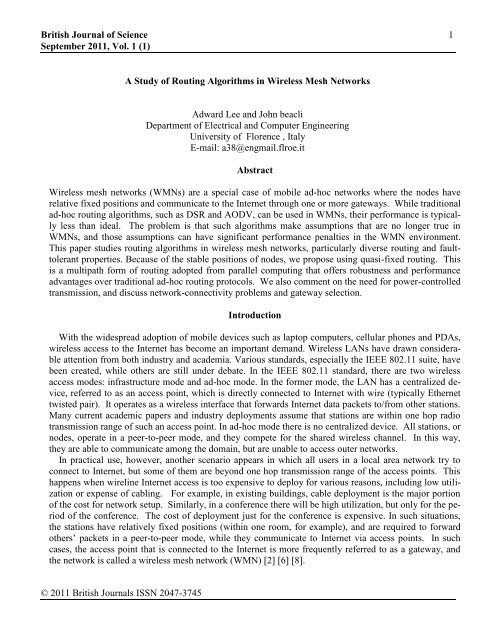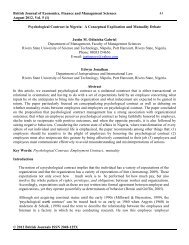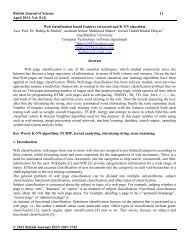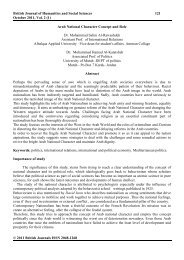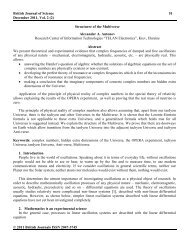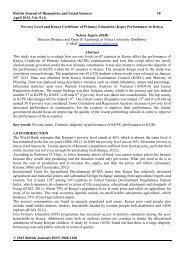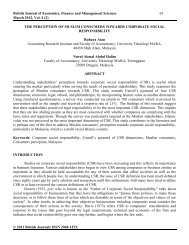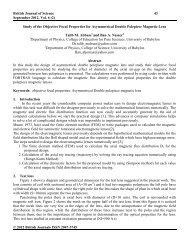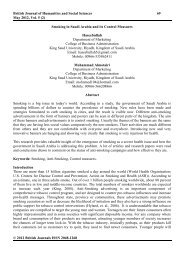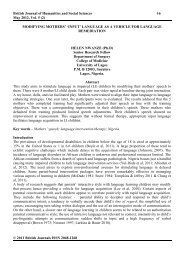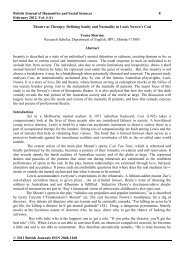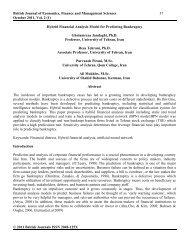A Study of Routing Algorithm in Wireless Mesh Networks
A Study of Routing Algorithm in Wireless Mesh Networks
A Study of Routing Algorithm in Wireless Mesh Networks
You also want an ePaper? Increase the reach of your titles
YUMPU automatically turns print PDFs into web optimized ePapers that Google loves.
British Journal <strong>of</strong> Science 1<br />
September 2011, Vol. 1 (1)<br />
A <strong>Study</strong> <strong>of</strong> <strong>Rout<strong>in</strong>g</strong> <strong>Algorithm</strong>s <strong>in</strong> <strong>Wireless</strong> <strong>Mesh</strong> <strong>Networks</strong><br />
Adward Lee and John beacli<br />
Department <strong>of</strong> Electrical and Computer Eng<strong>in</strong>eer<strong>in</strong>g<br />
University <strong>of</strong> Florence , Italy<br />
E-mail: a38@engmail.flroe.it<br />
Abstract<br />
<strong>Wireless</strong> mesh networks (WMNs) are a special case <strong>of</strong> mobile ad-hoc networks where the nodes have<br />
relative fixed positions and communicate to the Internet through one or more gateways. While traditional<br />
ad-hoc rout<strong>in</strong>g algorithms, such as DSR and AODV, can be used <strong>in</strong> WMNs, their performance is typically<br />
less than ideal. The problem is that such algorithms make assumptions that are no longer true <strong>in</strong><br />
WMNs, and those assumptions can have significant performance penalties <strong>in</strong> the WMN environment.<br />
This paper studies rout<strong>in</strong>g algorithms <strong>in</strong> wireless mesh networks, particularly diverse rout<strong>in</strong>g and faulttolerant<br />
properties. Because <strong>of</strong> the stable positions <strong>of</strong> nodes, we propose us<strong>in</strong>g quasi-fixed rout<strong>in</strong>g. This<br />
is a multipath form <strong>of</strong> rout<strong>in</strong>g adopted from parallel comput<strong>in</strong>g that <strong>of</strong>fers robustness and performance<br />
advantages over traditional ad-hoc rout<strong>in</strong>g protocols. We also comment on the need for power-controlled<br />
transmission, and discuss network-connectivity problems and gateway selection.<br />
Introduction<br />
With the widespread adoption <strong>of</strong> mobile devices such as laptop computers, cellular phones and PDAs,<br />
wireless access to the Internet has become an important demand. <strong>Wireless</strong> LANs have drawn considerable<br />
attention from both <strong>in</strong>dustry and academia. Various standards, especially the IEEE 802.11 suite, have<br />
been created, while others are still under debate. In the IEEE 802.11 standard, there are two wireless<br />
access modes: <strong>in</strong>frastructure mode and ad-hoc mode. In the former mode, the LAN has a centralized device,<br />
referred to as an access po<strong>in</strong>t, which is directly connected to Internet with wire (typically Ethernet<br />
twisted pair). It operates as a wireless <strong>in</strong>terface that forwards Internet data packets to/from other stations.<br />
Many current academic papers and <strong>in</strong>dustry deployments assume that stations are with<strong>in</strong> one hop radio<br />
transmission range <strong>of</strong> such an access po<strong>in</strong>t. In ad-hoc mode there is no centralized device. All stations, or<br />
nodes, operate <strong>in</strong> a peer-to-peer mode, and they compete for the shared wireless channel. In this way,<br />
they are able to communicate among the doma<strong>in</strong>, but are unable to access outer networks.<br />
In practical use, however, another scenario appears <strong>in</strong> which all users <strong>in</strong> a local area network try to<br />
connect to Internet, but some <strong>of</strong> them are beyond one hop transmission range <strong>of</strong> the access po<strong>in</strong>ts. This<br />
happens when wirel<strong>in</strong>e Internet access is too expensive to deploy for various reasons, <strong>in</strong>clud<strong>in</strong>g low utilization<br />
or expense <strong>of</strong> cabl<strong>in</strong>g. For example, <strong>in</strong> exist<strong>in</strong>g build<strong>in</strong>gs, cable deployment is the major portion<br />
<strong>of</strong> the cost for network setup. Similarly, <strong>in</strong> a conference there will be high utilization, but only for the period<br />
<strong>of</strong> the conference. The cost <strong>of</strong> deployment just for the conference is expensive. In such situations,<br />
the stations have relatively fixed positions (with<strong>in</strong> one room, for example), and are required to forward<br />
others’ packets <strong>in</strong> a peer-to-peer mode, while they communicate to Internet via access po<strong>in</strong>ts. In such<br />
cases, the access po<strong>in</strong>t that is connected to the Internet is more frequently referred to as a gateway, and<br />
the network is called a wireless mesh network (WMN) [2] [6] [8].<br />
© 2011 British Journals ISSN 2047-3745
British Journal <strong>of</strong> Science 2<br />
September 2011, Vol. 1 (1)<br />
In this paper we discuss the unique aspects <strong>of</strong> wireless mesh networks, and their differences from adhoc<br />
networks. In particular, we propose an algorithm for rout<strong>in</strong>g <strong>in</strong> such networks that is able to take advantage<br />
<strong>of</strong> the capabilities <strong>of</strong> such networks that are not present <strong>in</strong> ad-hoc networks. We provide some<br />
evidence that the approach we propose is likely to perform noticeably better than exist<strong>in</strong>g ad-hoc rout<strong>in</strong>g<br />
protocols.<br />
This rema<strong>in</strong>der <strong>of</strong> this paper is organized as follows. In Section II we <strong>in</strong>troduce wireless mesh networks<br />
and our diverse-rout<strong>in</strong>g algorithm. We describe its advantages, and give evidence that it will be a<br />
superior approach. In Section III we study the power-aware network connectivity problem. Section IV<br />
briefly discusses the impact <strong>of</strong> gateway selection on network performance. F<strong>in</strong>ally, <strong>in</strong> Section V, we<br />
conclude the paper.<br />
<strong>Wireless</strong> <strong>Mesh</strong> Network and Diverse <strong>Rout<strong>in</strong>g</strong><br />
<strong>Wireless</strong> mesh networks have the potential to play a critical role as an alternative technology for lastmile<br />
broadband Internet access. They can be viewed as a special case <strong>of</strong> wireless multi-hop ad-hoc networks,<br />
<strong>in</strong> which each node operates both as a host and as a router. However, WMNs have a number <strong>of</strong><br />
features that dist<strong>in</strong>guish them from pure ad-hoc networks. First, the positions <strong>of</strong> different nodes <strong>of</strong> a<br />
WMN are relatively fixed. By relatively fixed position, we mean that, although the nodes may not be absolutely<br />
immobile, any change <strong>of</strong> position is limited with<strong>in</strong> certa<strong>in</strong> range. The implication <strong>of</strong> this is that<br />
rout<strong>in</strong>g paths can be created that are likely to be stable. This substantially reduces the need for rout<strong>in</strong>g<br />
packet overhead. Indeed, such rout<strong>in</strong>g packets are likely only needed at <strong>in</strong>itialization and when traffic<br />
volume is sufficiently low that a node cannot be sure that its neighbour is still present, as opposed to hav<strong>in</strong>g<br />
crashed. Second, unlike pure ad-hoc networks, where the traffic flows between arbitrary pairs <strong>of</strong><br />
nodes, <strong>in</strong> WMN, all traffic is either to or from a designated gateway, which connects the wireless mesh<br />
network to the Internet. The relevance <strong>of</strong> this po<strong>in</strong>t is that the traffic may be split over multiple gateways,<br />
so as to reduce the load with<strong>in</strong> any given portion <strong>of</strong> the network. Third, the nodes will typically have<br />
access to a power source, and so power consumption is not a critical issue. F<strong>in</strong>ally, such systems can be<br />
created with<strong>in</strong> a s<strong>in</strong>gle doma<strong>in</strong> <strong>of</strong> authority, and so many security issues present <strong>in</strong> ad hoc networks are<br />
no longer relevant.<br />
<strong>Wireless</strong> mesh networks are, as with pure ad hoc networks, easy to <strong>in</strong>stall. The setup cost for Internet<br />
service providers (ISPs) is only gateway <strong>in</strong>stallation and configuration. This makes WMNs a good choice<br />
compared to traditional directional antenna wireless access. Scalability is a second advantage for WMNs.<br />
When new subscribers activate their Internet connections, ISPs only need to perform an authentication<br />
process to decide whether to admit or deny. Nodes can be added one at a time, and the more nodes admitted,<br />
the more reliable the network, because a densely distributed network tends to ma<strong>in</strong>ta<strong>in</strong> higher<br />
connectivity. Traditional directional antenna networks, on the other hand, suffer from poor scalability<br />
s<strong>in</strong>ce, when a new subscriber is admitted, the antenna’s direction has to be manually adjusted. Furthermore,<br />
if a new gateway is <strong>in</strong>stalled to alleviate heavy traffic, half <strong>of</strong> exist<strong>in</strong>g subscribers’ antennae should<br />
be re-aimed to new gateway, putt<strong>in</strong>g a heavy cost on ISPs.<br />
Ad-hoc network rout<strong>in</strong>g algorithms, such as AODV, DSR and many <strong>of</strong> their extensions, are complex<br />
because they need to deal with the possibility <strong>of</strong> highly mobile nodes. There has, therefore, been significant<br />
attention put on route discovery and ma<strong>in</strong>tenance. Although ad-hoc networks’ rout<strong>in</strong>g algorithms<br />
can be directly applied <strong>in</strong> WMNs, the relatively stationary topology <strong>of</strong> WMNs suggests that we could develop<br />
much more simplified rout<strong>in</strong>g algorithms. Further, the traffic pattern <strong>in</strong> WMNs is such that alternate<br />
protocols are likely preferred.<br />
© 2011 British Journals ISSN 2047-3745
British Journal <strong>of</strong> Science 3<br />
September 2011, Vol. 1 (1)<br />
The most commonly used topology for wireless mesh networks is a grid layout, due to the layout <strong>of</strong><br />
build<strong>in</strong>gs. S<strong>in</strong>ce each node would communicate with the gateway, it must do so either directly, if it is<br />
with<strong>in</strong> the radio transmission range, or <strong>in</strong>directly, which requires other nodes to forward packets. In order<br />
to m<strong>in</strong>imize the collision probability, each node should adjust its power to a level that is able to reach its<br />
four direct neighbors, and no more. This, thus, forms a grid network. Therefore, we can adopt a quasixy-rout<strong>in</strong>g<br />
algorithm <strong>in</strong> WMN. Xy-rout<strong>in</strong>g is commonly used <strong>in</strong> mesh or torus topology parallel computers<br />
to avoid deadlock <strong>in</strong> wormhole rout<strong>in</strong>g [1]. In WMN with this grid topology, each node routes to its<br />
direct neighbours. For example, a node (x, y) <strong>in</strong> Fig. 1 has direct neighbors (x-1, y), (x+1, y), (x, y-1), (x,<br />
y+1). Each node performs packet forward<strong>in</strong>g for its neighbors to and from the gateway.<br />
Packet delay is caused by various reasons, <strong>in</strong>clud<strong>in</strong>g collision resolution dur<strong>in</strong>g packet forward<strong>in</strong>g,<br />
packet buffer<strong>in</strong>g, and different schedul<strong>in</strong>g algorithms. However, the most critical cause is packet delay <strong>in</strong><br />
WMN is path length. Under the same traffic <strong>in</strong>tensity, a smaller number <strong>of</strong> hops would lead to less packet<br />
delay. For two nodes, S (x S , y S ) and D (x D , y D ), <strong>in</strong> a grid network, their shortest distance is given by:<br />
d = | x S – x D | + | y S – y D | (1)<br />
To m<strong>in</strong>imize packet delay we wish to use the shortest path. However, this must be done <strong>in</strong> the context<br />
<strong>of</strong> m<strong>in</strong>imiz<strong>in</strong>g collisions, s<strong>in</strong>ce highly-contended paths that are shortest are not necessarily ideal [9]. We<br />
therefore propose a shortest-path load-balanc<strong>in</strong>g diverse rout<strong>in</strong>g protocol. Our protocol is as follows:<br />
1. if the next hop is a gateway, compete for<br />
transmission with it; else<br />
2. determ<strong>in</strong>e neighbour nodes’ load;<br />
3. select a lightly-loaded path for next hop and<br />
transmit;<br />
4. go to step 1.<br />
Step 2 enables the current node to acquire a picture <strong>of</strong> local network traffic. We presume this may be<br />
achieved by promiscuous snoop<strong>in</strong>g <strong>of</strong> the medium. While <strong>in</strong> a pure ad-hoc network the cost <strong>of</strong> such<br />
snoop<strong>in</strong>g may be too high, <strong>in</strong> terms <strong>of</strong> energy consumption, <strong>in</strong> the WMN context this should be quite<br />
feasible. Step 3 is then a simple matter <strong>of</strong> select<strong>in</strong>g the lightest-load node. There will, <strong>in</strong> general, be just<br />
two choices for any given dest<strong>in</strong>ation, presum<strong>in</strong>g that a shortest path route is desired. Alternately, the<br />
current node can skip step 2 and simply randomly alternate between the two choices (e.g. right or down<br />
<strong>in</strong> Fig. 1). In this manner our protocol achieves diverse rout<strong>in</strong>g. The number <strong>of</strong> paths available is then<br />
determ<strong>in</strong>ed accord<strong>in</strong>g to the follow<strong>in</strong>g theorem.<br />
Theorem 1: For any two given node S (x S , y S ) and D (x D , y D ) <strong>in</strong> a wireless mesh network, there exists<br />
different routes that have distance d, given <strong>in</strong> Eq. 1.<br />
Pro<strong>of</strong>: We prove the theorem by <strong>in</strong>duction. Without loss <strong>of</strong> generality, assume x S ≤ x D and y S ≤ y D .<br />
Step 1. From S (x S , y S ) to (x S , y S +1), there is only one path; Likewise for S (x S , y S ) to (x S +1, y S ). The<br />
number <strong>of</strong> shortest paths between S (x S , y S ) to (x S +1, y S +1) is 2, which is a summation <strong>of</strong> the above 2.<br />
© 2011 British Journals ISSN 2047-3745
British Journal <strong>of</strong> Science 4<br />
September 2011, Vol. 1 (1)<br />
S 1 1 1 1 1<br />
1<br />
2<br />
3<br />
4<br />
5 6<br />
1<br />
3<br />
6<br />
10<br />
15 21<br />
1<br />
4<br />
10<br />
20<br />
35 56<br />
1<br />
5<br />
15<br />
35<br />
70<br />
126<br />
1<br />
6<br />
21<br />
56<br />
126<br />
252<br />
D<br />
Fig. 1. Diverse Route Calculation.<br />
Step 2. Suppose from S to T(x T , y T ), the number <strong>of</strong> shortest paths is<br />
Aga<strong>in</strong>, suppose x S ≤ x T and y S ≤ y T .<br />
Step 3. From S to (x T +1, y T ), the number <strong>of</strong> shortest paths can be calculated recursively as<br />
From S to (x T , y T +1), the number <strong>of</strong> paths is<br />
Therefore, from S to (x T +1, y T +1), the paths are a sum <strong>of</strong> the above two, because the paths must go<br />
through either (x T +1, y T ) or (x T , y T +1). That is,<br />
which is<br />
.<br />
The question then arises as to how useful our approach would be. Jones [9] has performed extensive<br />
experiments <strong>in</strong> multipath WMN rout<strong>in</strong>g algorithms, us<strong>in</strong>g source-based rout<strong>in</strong>g. In particular, his work<br />
demonstrated the follow<strong>in</strong>g. First, s<strong>in</strong>gle-flow multipath rout<strong>in</strong>g to/from separate gateways can improve<br />
the performance by up to a factor <strong>of</strong> two over s<strong>in</strong>gle-path rout<strong>in</strong>g, as is used <strong>in</strong> AODV and DSR. Second,<br />
<strong>in</strong> grid networks <strong>of</strong> 10*10 nodes, with sources and dest<strong>in</strong>ations selected randomly, us<strong>in</strong>g multipath<br />
rout<strong>in</strong>g aggregate throughput <strong>in</strong>creased by between 5% and 61%, with an average <strong>in</strong>crease <strong>of</strong> 27%. This<br />
<strong>in</strong>dicates that the multipath rout<strong>in</strong>g can improve the performance <strong>of</strong> grid networks. We expect that our<br />
approach will yield better results than Jones because we dynamically adjust the path on route, based on<br />
current load.<br />
Apart from rout<strong>in</strong>g issues, many researchers are concerned with schedul<strong>in</strong>g algorithms <strong>in</strong> WMN [4] [5].<br />
Jakubczak et al. [3] observed that nodes close to a gateway tend to have better chance for transmission<br />
when compet<strong>in</strong>g for the shared wireless channel with others that are further away from the gateway. Both<br />
© 2011 British Journals ISSN 2047-3745
British Journal <strong>of</strong> Science 5<br />
September 2011, Vol. 1 (1)<br />
Jakubczak et al. [3] and Munawar [7] <strong>of</strong>fer schedul<strong>in</strong>g algorithms that achieve both fairness and high<br />
throughput.<br />
Fault Tolerance <strong>in</strong> <strong>Wireless</strong> <strong>Mesh</strong> Network<br />
In the previous section, we discuss rout<strong>in</strong>g issues for wireless mesh networks. For a relatively stationary<br />
topology, it is easy to f<strong>in</strong>d a route from an <strong>in</strong>dividual node to a gateway, as compared to ad-hoc network<br />
rout<strong>in</strong>g. This section addresses the route-ma<strong>in</strong>tenance problem.<br />
In ad-hoc networks, route failure is ma<strong>in</strong>ly caused by node mobility or power-<strong>of</strong>f. Most rout<strong>in</strong>g algorithms<br />
would produce a route-error message, and trigger re-rout<strong>in</strong>g. In wireless mesh networks, where<br />
nodes tend not to move, route failure is most probably caused by power-<strong>of</strong>f or system failure. Under this<br />
circumstance, we may re-route with another diverse path. Note that for stations on the boundary <strong>of</strong> a<br />
mesh network, we do not need to strictly follow the shortest-distance diverse path. If a node’s only adjacent<br />
neighbor fails, the node becomes an island. We would then <strong>in</strong>crease its power level so that it can<br />
reach other neighbors. This scenario is illustrated <strong>in</strong> Fig. 2.<br />
A<br />
Fig. 2. Island node A and its different power levels.<br />
Our scheme is to keep the power level as low as possible. Although a higher power level can reach a<br />
longer distance, and thus require fewer hops, it will also lead to more <strong>in</strong>terference with other nodes, <strong>in</strong>creas<strong>in</strong>g<br />
the collision probability. In an extreme situation, where each node can hear every other node, a<br />
lot <strong>of</strong> collision will happen, and will have to be resolved with a much longer back-<strong>of</strong>f time, especially <strong>in</strong><br />
heavy-traffic situations. There is always a trade-<strong>of</strong>f between network capacity and throughput [4]. Therefore,<br />
we try to keep the power to a low level. When the gateway is not the performance bottleneck, multiple<br />
packet-forward<strong>in</strong>g paths with fewer collisions can improve network throughput.<br />
However, if a station is unable to reach other nodes, it will have to <strong>in</strong>crease its power level to f<strong>in</strong>d<br />
some neighbours. In the same way, if a node jo<strong>in</strong>s the network, it will first look for its neighbors. Some<br />
island nodes might restore their power upon a new node’s appearance, which could connect them to gateway<br />
<strong>in</strong> a normal mesh. How to f<strong>in</strong>d an alternative path dur<strong>in</strong>g network failure is critical <strong>in</strong> wireless<br />
mesh networks.<br />
Gateway’s Effect on Performance<br />
Due to the traffic pattern, most <strong>of</strong> the data packets are to or from designated gateway. As such, it is difficult<br />
or impossible to balance the load between nodes close to gateway and other nodes. With diverse<br />
rout<strong>in</strong>g, we have tried to balance the load among different rout<strong>in</strong>g paths to the gateway <strong>in</strong> order to avoid<br />
<strong>in</strong>terference. Further, we presume nodes can use multi gateways. F<strong>in</strong>ally, we note that placement <strong>of</strong><br />
gateways at different positions <strong>in</strong> the mesh can have a direct effect on network throughput. For example,<br />
© 2011 British Journals ISSN 2047-3745
British Journal <strong>of</strong> Science 6<br />
September 2011, Vol. 1 (1)<br />
<strong>in</strong> Fig. 1, a gateway at a corner, rather than at the center, will more likely result <strong>in</strong> a higher delay and<br />
lower throughput for the mesh.<br />
optimal case<br />
throughput<br />
poor performance<br />
0<br />
number <strong>of</strong> gateways<br />
Fig. 3. Throughput should <strong>in</strong>crease with<br />
number <strong>of</strong> gateways.<br />
When traffic <strong>in</strong>creases to certa<strong>in</strong> amount that the exist<strong>in</strong>g gateways cannot handle any more, add<strong>in</strong>g<br />
new gateways <strong>in</strong> mesh network could greatly alleviate congestion. For example, <strong>in</strong> a conference center<br />
when several conferences are held simultaneously, the organizers might place additional gateways to<br />
meet the <strong>in</strong>creas<strong>in</strong>g Internet traffic. In this situation, ma<strong>in</strong>ta<strong>in</strong><strong>in</strong>g a balanced load among all gateways is<br />
important. The throughput <strong>of</strong> a load-balanced network would ideally grow l<strong>in</strong>early with the <strong>in</strong>crement <strong>of</strong><br />
gateway numbers.<br />
Specifically, we propose to build some <strong>in</strong>telligent gateways that can perform virtual private network<br />
(VPN) functions. Because <strong>of</strong> the simplified rout<strong>in</strong>g issue, nodes might be able to use a local address, say,<br />
(x, y), to route Internet packets, and the packets are encapsulated at <strong>in</strong>telligent gateway and forwarded by<br />
other nodes. This would further allow multiple WMN subscribers to share limited number <strong>of</strong> IP addresses,<br />
if gateways can do address conversion.<br />
Conclusion<br />
<strong>Wireless</strong> mesh networks are a special case <strong>of</strong> ad-hoc networks. S<strong>in</strong>ce they are easy to setup and ma<strong>in</strong>ta<strong>in</strong>,<br />
and have good scalability, WMNs are potentially a popular wireless-access method for hospitals, hotels,<br />
and conference centers. This paper studies rout<strong>in</strong>g algorithms for wireless mesh networks, us<strong>in</strong>g diverse<br />
rout<strong>in</strong>g, which addresses load-balanc<strong>in</strong>g and fault-tolerance problems. The gateway’s effect on<br />
network performance is also discussed.<br />
Future research is needed to <strong>in</strong>tegrate rout<strong>in</strong>g and schedul<strong>in</strong>g algorithms and study wireless mesh network’s<br />
performance. The number <strong>of</strong> gateways and their placement are also significant open problem,<br />
with network topology hav<strong>in</strong>g a great impact on the f<strong>in</strong>al results. Particularly, <strong>in</strong> most papers, symmetric<br />
traffic is assumed. That is, all the nodes have similar traffic <strong>in</strong>tensity. This is not the case <strong>in</strong> most applications,<br />
where most users’ bandwidth demand is small, while a small portion <strong>of</strong> users have large bulk- or<br />
stream<strong>in</strong>g-data transmission. A measurement study on wireless network’s traffic model is needed.<br />
References<br />
Jose Duato, Interconnection <strong>Networks</strong>: An Eng<strong>in</strong>eer<strong>in</strong>g Approach, IEEE Computer Society: Los Alamitos,<br />
LA, USA, 1997.<br />
© 2011 British Journals ISSN 2047-3745
British Journal <strong>of</strong> Science 7<br />
September 2011, Vol. 1 (1)<br />
J. J. Garcia-Luna-Aceves, Chane L. Fullmer, Ewerton Madruga, David Beyer, Thane Frivold, “<strong>Wireless</strong><br />
Internet Gateways (WINGS)”, Proceed<strong>in</strong>gs <strong>of</strong> MILCOM’97, vol. 3, pp1271-1276, 1997.<br />
Simon Jakubczak, Alex T.K. Lau, Lily Li, and Paul A.S. Ward, “An Explicit Rate-Control Fairness <strong>Algorithm</strong><br />
for <strong>Wireless</strong> <strong>Mesh</strong> <strong>Networks</strong>”, Technical Report, University <strong>of</strong> Waterloo, 2004.<br />
Jangeun Jun and Mihail L. Sichitiu, “The Nom<strong>in</strong>al Capacity <strong>of</strong> <strong>Wireless</strong> <strong>Mesh</strong> <strong>Networks</strong>”, IEEE <strong>Wireless</strong><br />
Communications (October 2003) 8-14.<br />
Jangeun Jun and Mihail L. Sichitiu, “Fairness and QoS <strong>in</strong> Multihop <strong>Wireless</strong> <strong>Networks</strong>”, Proceed<strong>in</strong>gs <strong>of</strong><br />
IEEE Vehicular Technology Conference (VTC), pp2936-2940, 2003.<br />
R. Luo, D. Belis, R. M. Edwards, G. A. Manson, “A Simulation Design for L<strong>in</strong>k Connection-oriented<br />
<strong>Wireless</strong> <strong>Mesh</strong> <strong>Networks</strong>”, International Workshop on Mobile and <strong>Wireless</strong> Communications Network,<br />
pp665-669, 2002.<br />
Mohammad A. Munawar, “Multi-<strong>in</strong>terface Multi-channel <strong>Wireless</strong> <strong>Mesh</strong> <strong>Networks</strong>”, Master’s thesis,<br />
University <strong>of</strong> Waterloo, Waterloo, Ontario, 2004.<br />
Brad Schrick, Michael J. Riezenman, “<strong>Wireless</strong> Broadband <strong>in</strong> a Box”, IEEE Spectrum (June 2002)<br />
41-43.<br />
Even Jones, “Multipath Load Balanc<strong>in</strong>g <strong>in</strong> Multi-hop <strong>Wireless</strong> <strong>Networks</strong>”, Technical Report, University<br />
<strong>of</strong> Waterloo, 2004.<br />
© 2011 British Journals ISSN 2047-3745


